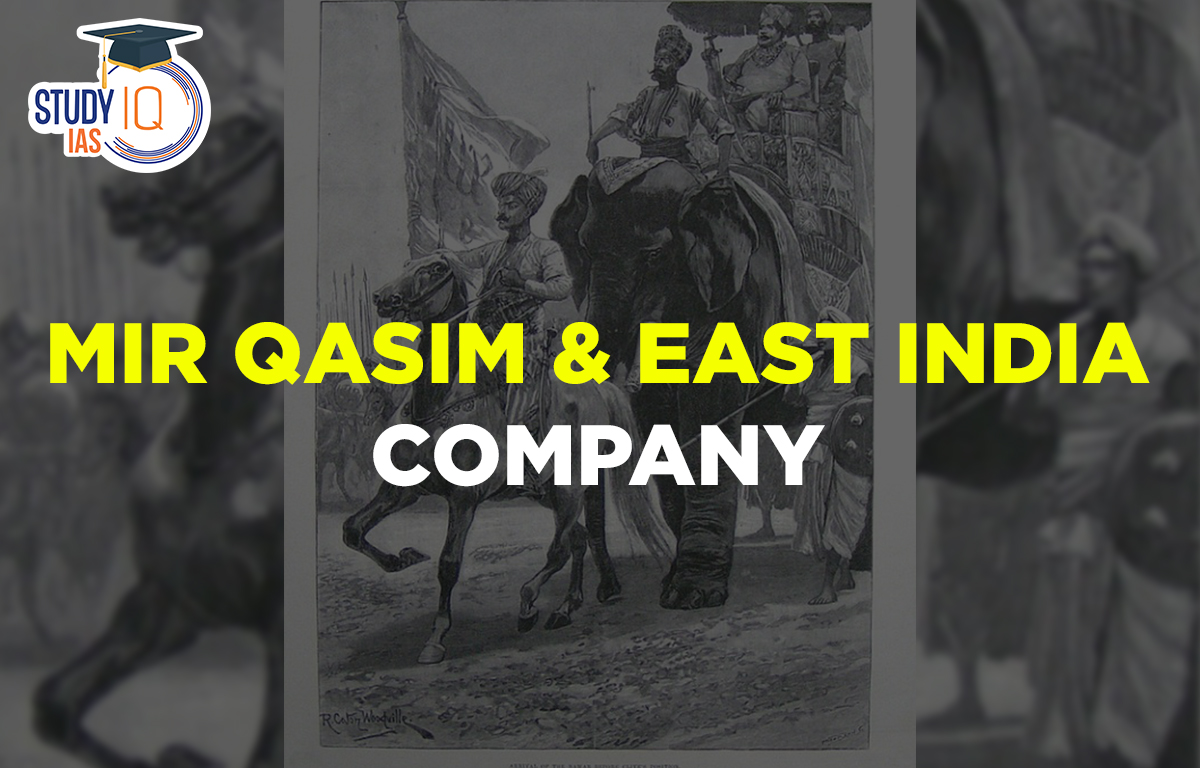Table of Contents
Mir Qasim & East India Company
Following the Battle of Chinsura, the British overthrew Mir Jafar and installed Mir Kasim as the new Nawab of Bengal. Mir Kasim soon started to demonstrate his own will and embrace his aspirations of independence. Later, he moved his headquarters from Murshidabad to Munger in Bihar, where he amassed a separate army. The unfettered trade was the issue.
The British East India Company bought duty-free trading privileges in the entirety of Bengal from the Farrukhsiyar dynasty in 1717 for just three thousand rupees per year. For UPSC exam preparation, review all the information pertaining to Mir Qasim & East India Company.
Mir Qasim & East India Company Treaty
Mir Kasim consented to hand up the districts of Burdwan, Midnapur, Chittagong, as well as one-half of the chunam trade of Sylhet, to the Company. Mir Kasim consented to settle the Company’s unpaid debts and pledged to provide Rs. 5 lakh to the Company’s war funding in Southern India. It was decided that neither the Company’s land nor the nawab’s tenants would be permitted to establish themselves there.
The Company believed that they had discovered the perfect puppet in Mir Kasim. Mir Kasim, however, defied what the Company had anticipated. He was unable to participate in the imperialism game.
Mir Kasim and Measure Taken
Mir Kasim moved the capital from Murshidabad to Monghyr in Bihar after assuming control in order to maintain a safe distance from the Company in Calcutta. He redesigned the army to increase its competence and efficiency while also reorganizing the bureaucracy with the personnel of his choosing. He understood the value of a well-trained army and treasury to keep his independence.
In an effort to quell unrest, he built up a cutting-edge army along European lines. He attempted to clean up the revenue department’s corruption in order to maximize his income.
Mir Qasim & East India Company Conflict
The issue that caused Mir Kasim and the Company to argue was how inland duties were handled. The Nawab took issue with the Company’s servants engaging in inland private trade without paying any duties by abusing the Company’s dastak. For a commission, the Company’s employees sold its dastak to Indian traders.
The Company’s employees were not willing to conduct business without paying inland duties. Inland commerce abuses severely reduced the Nawab’s income and rendered his Indian people defenceless. Due to the Company’s authorities’ adamant stance, all attempts at a peaceful resolution failed.
Mir Kasim took the bold decision to abolish all inland tariffs, putting Indian traders on an equal footing with English traders. The majority of the Governor’s Council members desired to force the Nawab to tax his subjects since only under such situation could English merchants take advantage of the dastak.
War broke out between the English and Mir Kasim in 1763 as a result of a dispute between the Nawab and Company about transit duties. Mir Kasim was the worst of the experiences that came after. In a last-ditch effort to drive the English out of Bengal, he fled to Oudh and organized a confederacy with Shuja-ud-daula (the Nawab of Awadh) and Shah Alam II (the fugitive Mughal Emperor).
Mir Qasim Death
On May 8, 1777, Mir Qasim passed away in obscurity and extreme poverty, likely from dropsy, in Kotwal, close to Delhi.
Mir Qasim & East India Company UPSC
In order to better the state’s affairs, Mir Qasim, a capable and powerful ruler, moved his capital from Murshidabad to Munger (Bihar) in 1762. He understood the necessity of a robust army and a rich treasury to preserve his independence. Mir Qasim saw himself as an independent king, which presented a challenge for the British because they desired to use him as a puppet. Find out everything there is to know about Mir Qasim & East India Company’s UPSC exam preparation in this article.


 Jallianwala Bagh Massacre, Date, History...
Jallianwala Bagh Massacre, Date, History...
 Important Lakes of India, State wise and...
Important Lakes of India, State wise and...
 Buddhism History, Origin, Sect, Councils...
Buddhism History, Origin, Sect, Councils...





















